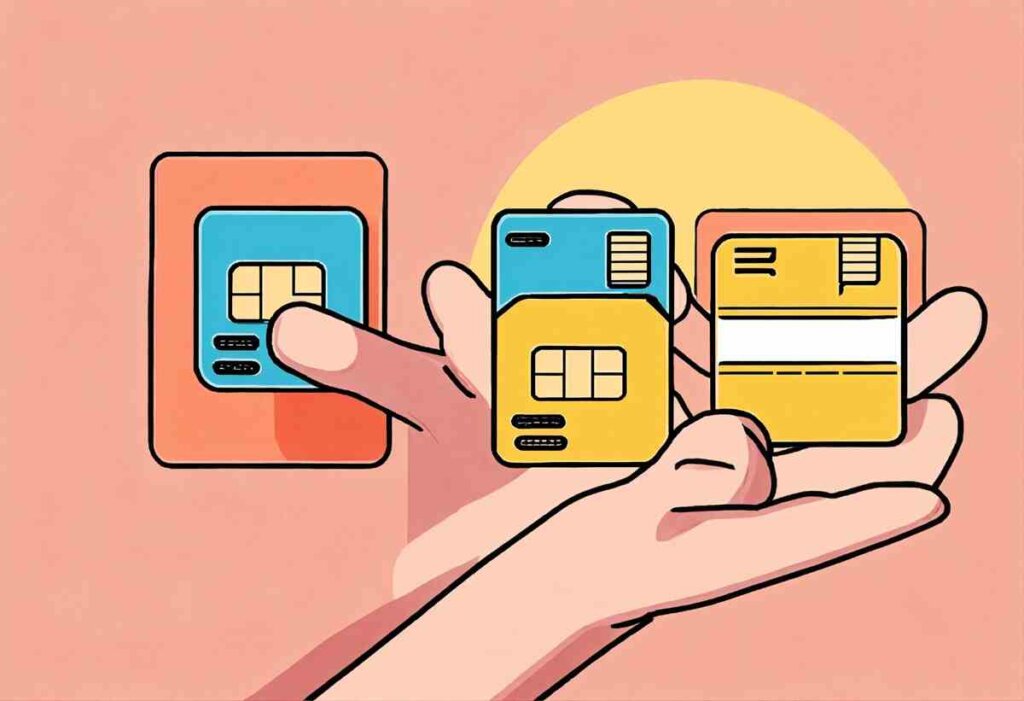The process typically involves contacting the issuing bank and submitting a request for the conversion. Some banks may offer online facilities for this purpose. For complete details read the below article.
Introduction
Great News! All Indian consumers of credit, debit, and prepaid cards will be able to switch networks starting on October 1.
Cardholders can now switch from Visa to MasterCard to RuPay or any other network, or vice versa, in the same way that you can switch between mobile networks like Vodafone, Jio, and Airtel.
In contrast to the current practice, where card network options are defined by agreements between issuers and networks, the Reserve Bank of India has released a new circular enabling users of debit, credit, and prepaid cards to choose their preferred card network.
Converting a Visa card to a RuPay card is a simple process that can offer significant benefits to individuals looking to manage their finances effectively.
But before that, lets first understand what card network portability is!

What is card network portability?
Card network portability was set to be implemented from October 1, 2023, in India.
Card network portability refers to the ability of credit cardholders to choose their desired card network, allowing them to switch from one network to another.
This initiative enables customers to select their preferred card network, such as Visa, MasterCard, RuPay, American Express, Diners Club International, among others.
The Reserve Bank of India (RBI) has introduced this concept to provide customers with the freedom to choose their card network, offering them more options and flexibility.
This move is aimed at empowering customers and promoting competition among card networks, ultimately benefiting the consumers.
The implementation of card network portability may face challenges such as card duplication, increased operational costs, and potential impacts on commercial agreements with network and co-branded partners.
However, it is expected to bring about a significant change for cardholders, allowing them to transfer their cards from one network to another, and providing them with the freedom to select their preferred card network.
ALSO READ: Rupay Card Vs Mastercard: Step By Step Comparison
ALSO READ: P2P Lending In India- A Complete Guide
Why Consider Switching to a Rupay Card?
Before we dive into the “how-to,” let’s explore the reasons why many individuals are seeking a “Visa card to Rupay card conversion.”
Here are some key motivators:
- Supporting local initiatives: Rupay cards promote India’s digital payment ecosystem, potentially leading to lower transaction costs and improved financial inclusion.
- Attractive benefits: Several Rupay cards offer enticing features like cashback, reward points, and discounts on specific purchases.
- Wider acceptance: While Visa boasts global reach, Rupay cards are increasingly accepted across India, even in smaller towns and cities.
- Lower fees: Some Rupay cards boast lower annual fees and transaction charges compared to certain Visa cards, especially for domestic transactions.
Steps to Convert Visa Card to RuPay Card
To convert a Visa card to a RuPay card, individuals can follow these general steps:
- Contact the Issuing Bank: Reach out to the bank that issued the Visa card and inquire about the process for converting it to a RuPay card.
- Submit an Application: Complete the necessary application form provided by the bank for the conversion. This may involve visiting the bank branch or using the bank’s online application portal.
- Provide Required Documents: Be prepared to submit essential documents, such as recent passport-sized photographs and bank account details, including the account number, to link the RuPay credit card with the bank account.
- Await Confirmation: After submitting the application and required documents, the bank will guide the applicant through the transition process. Once approved, the individual will receive the RuPay card.

If you still want to know more about RuPay cards & related information, read below:
What is RuPay Card
RuPay cards are accepted widely in India and offer several benefits such as lower transaction costs, enhanced security features, and rewards programs.
RuPay cards are comparable to Visa cards in terms of their features and benefits.
Benefits of RuPay Cards
RuPay cards offer several benefits, including lower processing charges, transaction costs, and enhanced security features.
RuPay cards also offer rewards programs, such as cashback and discounts, making them an attractive option for individuals looking to manage their finances effectively.
ALSO READ: What is the disadvantage of RuPay? An Eye Opener!

Popular RuPay Card Variants
As you know, RuPay cards have emerged as a prominent player in India’s digital payment landscape, offering various options catered to diverse needs.
Whether you’re a savvy shopper, a prudent saver, or a frequent flyer, there’s a RuPay card tailored just for you.
Let’s dive into the world of popular RuPay card variants to help you make an informed choice:
Debit Cards
- Classic: Ideal for everyday transactions, offering basic features like ATM withdrawals, online payments, and point-of-sale purchases. Examples include SBI RuPay Classic Debit Card and HDFC Bank Easy RuPay Debit Card.
- Platinum: A step up from classic, offering higher transaction limits, reward points, and additional benefits like airport lounge access or insurance coverage. Popular picks include ICICI Bank HPCL Super Saver RuPay Platinum Card and Kotak Mahindra RuPay Select Debit Card.
- Select: Designed for premium lifestyles, these cards often come with higher reward programs, exclusive discounts, and concierge services. Some notable options include Axis Bank Miles & More Platinum RuPay Card and IndusInd Bank Club Solitaire RuPay Select Debit Card.
Credit Cards
- Classic: Similar to classic debit cards, offering credit with basic features like revolving credit limits, reward points, and EMI options. Examples include Bank of Baroda RuPay Select Credit Card and PNB Jawan RuPay Classic Credit Card.
- Platinum: Boast higher credit limits, accelerated reward programs, and travel-related benefits like airport lounge access and travel insurance. Popular choices include HDFC Bank Freedom RuPay Credit Card and DCB Payless Platinum RuPay Credit Card.
- Select: Cater to high-spending individuals, featuring premium reward programs, exclusive partnerships, and airport lounge access. Some prominent options include ICICI Bank Sapphiro RuPay Select Credit Card and Yes Bank First Platinum RuPay Select Credit Card.
Prepaid Cards
- Classic: Simple reloadable cards ideal for budgeting or gifting purposes. Examples include RuPay On-The-Go and Airtel Payments RuPay Prepaid Card.
- Corporate: Designed for businesses to manage employee expenses or distribute reimbursements. Popular options include HDFC Bank Corporate RuPay Card and Sodexo Meal Pass RuPay Corporate Card.
- Government Scheme: Issued by the government for specific initiatives like social welfare programs or subsidies. Examples include PMJDY RuPay Card and Mudra RuPay Card.
ALSO READ: How To Start A Neobank In India? A Complete Guide
Recent Developments and Regulatory Changes
The Reserve Bank of India (RBI) has proposed credit card portability, which will allow credit card users to switch between different credit card providers without changing their credit card number.
This will increase flexibility and choices for credit card users in India.
Conclusion
Converting a Visa card to a RuPay card is a simple process that can offer significant benefits to individuals looking to manage their finances effectively.
RuPay cards offer lower processing charges, transaction costs, and enhanced security features. Popular RuPay card variants include the Premier RuPay Credit Card, IndianOil HDFC RuPay Credit Card, and SBI RuPay BPCL Platinum.
With the RBI’s proposal for credit card portability, credit card users in India can look forward to increased flexibility and choices in the future.
By making the switch to a RuPay card, individuals can enjoy the benefits of a widely accepted, secure, and cost-effective payment solution.
FAQs
Can I use my Rupay card internationally?
Yes, you can use your RuPay Global card for international transactions.
RuPay Global is the first-of-its-kind international card payment network from India, and it is accepted wherever you see the logos of the international card networks it is affiliated with, such as Discover, Diners Club International, and JCB.
To ensure hassle-free international usage, it’s advisable to activate your RuPay card for international transactions before traveling abroad.
How long does the conversion process take?
The conversion process duration for switching from a Visa card to a RuPay card varies. In general, it can take from a few weeks to a few months, depending on the issuing bank and the specific requirements.
Customers are advised to inquire directly with their bank for precise timelines and details regarding the conversion process.
Which card is better RuPay or Visa?
RuPay and Visa are both payment systems that serve the same purpose, but they have some differences.
Visa is an international payment system that is accepted globally, while RuPay is a domestic payment system that caters to the needs of Indian consumers, merchants, and banks.
RuPay cards have lower processing charges and transaction costs, making them more practical for domestic use.
Visa cards, on the other hand, are available for both debit and credit cards, providing more flexibility to users.
Ultimately, the choice between RuPay and Visa depends on individual preferences and requirements.
Will RuPay overtake Visa?
RuPay, India’s indigenous payment card, has made significant strides in the country’s market.
It has been reported that in terms of credit cards, RuPay may overtake both Visa and Mastercard, reflecting the Indian government’s promotion of RuPay usage.
Additionally, RuPay and UPI accounted for 65.2 percent of all debit and credit card transactions as of August 31, 2018. The rise of RuPay has been attributed to its product features, increased accessibility to financial services, and its domestic focus, which has made it increasingly popular in India.
While VISA is accepted globally, RuPay caters to the domestic users, and its high levels of acceptance and the strength of the RuPay brand contribute to a better product experience.
Therefore, while RuPay’s growth is significant, whether it will overtake Visa globally remains to be seen, as Visa continues to be a dominant player in the international market.
Who is owner of RuPay?
RuPay is an Indian multinational financial service that offers credit cards that are widely accepted.
The National Payments Corporation of India (NPCI) is the owner of RuPay.
The NPCI is a not-for-profit organization that was founded in 2008 by the Reserve Bank of India (RBI) and Indian Banks’ Association (IBA). The NPCI was established to create a robust payment and settlement infrastructure in India.
RuPay was launched in May 2014, and since then, it has gained significant popularity in India. Presently, RuPay cards are issued by more than 1,100 banks, including Public Sector Banks, Private Sector Banks, Regional Rural and Co-Operative Banks.
Its ten core promoter banks are State Bank of India, Punjab National Bank, Canara Bank, Bank of Baroda, Union Bank of India, Bank of India, ICICI Bank, HDFC Bank, Citibank N. A., and HSBC.
What is the full form of RuPay?
The name “RuPay” is derived from the words ‘Rupee’ and ‘Payment’, emphasizing that it is India’s very own initiative for card payments.
Is RuPay card accepted in Google pay?
Yes, RuPay cards are accepted in Google Pay. Google Pay rolled out support for RuPay credit cards on UPI in May 2023, in association with the National Payments Association of India. Users can link their RuPay credit cards to Google Pay and make payments for online and offline transactions.
Is RuPay accepted on Amazon?
Yes, RuPay is accepted on Amazon as a payment method. Customers can use RuPay credit and debit cards to make purchases on Amazon India.
Other accepted payment methods on Amazon India include Visa, Mastercard, American Express, Diners Club, and Maestro debit cards.
Which apps accept RuPay?
RuPay cards are widely accepted in India, and several apps and websites support RuPay payments. Some of the popular apps that accept RuPay include:
- Amazon: Amazon accepts RuPay cards for online purchases, making it a convenient option for online shoppers.
- Flipkart: Flipkart, one of India’s largest e-commerce platforms, accepts RuPay cards for online transactions.
- Paytm: Paytm, a popular digital wallet and payment app, supports RuPay payments for various services, including mobile recharges, bill payments, and online shopping.
- IRCTC: The Indian Railway Catering and Tourism Corporation (IRCTC) accepts RuPay cards for booking train tickets online.
- Swiggy: Swiggy, a popular food delivery app, accepts RuPay cards for online payments.
These are just a few examples of the many apps and websites that accept RuPay payments.
As RuPay cards gain popularity in India, more merchants are likely to start accepting them as a payment option.
Rupay vs Visa debit card
RuPay cards are primarily for domestic use, offering lower processing fees, while Visa cards are designed for international transactions with a larger global acceptance. RuPay cards are only available as debit cards, linked to the user’s bank account, whereas Visa supports both credit and debit cards. While RuPay is gaining popularity in India, Visa is accepted globally.
Visa vs Mastercard vs Rupay
Visa and Mastercard are widely accepted globally, while RuPay is primarily used in India. RuPay cards generally have lower transaction fees compared to Visa and Mastercard. Visa and Mastercard offer a wide range of rewards, while RuPay may have fewer rewards but is more budget-friendly.
LATEST POSTS
- Best Paper Trading Application In India
- Ashneer Grover Net Worth: Income, Wealth & LifeStyle!
- Stock Trading In India For Beginners: Step By Step Guide
- Vastu Shastra For Home: Boost Positive Energy Of Your Home.
- ESG Full Form || ESG Investing: A Complete Guide
2024 apartment Banking biography book review books Broking cards cibil score complete guide credit cards demat esg investment facts finance fintech flats forex governement schemes home home buying home loan investment loan mindset mind to matter mivan technologies mutual funds neobanks nri OC and CC p2p personal finance plots plots in lucknow reading habits real estate real estate terms retirement planning reviews stock market tax benefit taxes trading vastu








